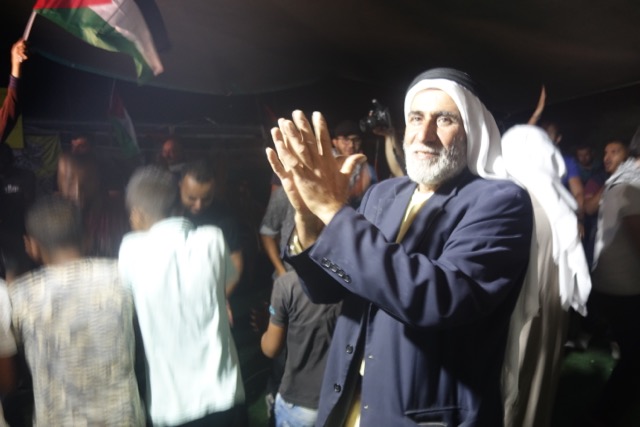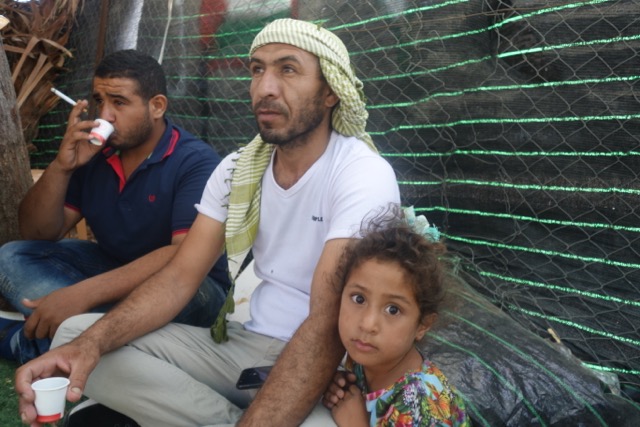Khan al-Ahmar: a Bedouin community near Jerusalem whose residents face the threat of forcible transfer to white metal housing containers on treeless, highway-sandwiched land.
July 10, 2018
Yousef and I have barely crossed the highway and climbed over the guardrail to approach Khan al-Ahmar when two Israeli police officers approach. They brandish papers in Hebrew and deny our entry into the village. An officer photographs our IDs and then we walk away from the village, along the highway, as we make plan B.
We flag down a ride with some Palestinian Authority (PA) employees who find another approach road. Part of a caravan of a half dozen PA cars, we slowly snake our way down a dusty rocky road leading into a wadi. As we near Khan al-Ahmar, we once again climb the hillside to reach the village. This time, the police are nowhere in sight. Within a couple hours, 200+ Palestinian dignitaries and activists as well as foreigners join village men and some children in Khan al-Ahmar’s tarped central gathering space. The forcible transfer of the villagers has been delayed by court order for another six days, until July 16.
Abdul Khader, age 8, borrows my camera and roams the plastic-grass-floored space taking photographs. He takes a photo of village leaders sitting in a line of plastic chairs and one of the top of his spiky dark hair. Later, he takes me by the hand and guides me over to the school, whose walls are constructed out of mud-covered tires.
Villagers and the visiting governor of Jerusalem make speeches before a line of video cameras. Water bottles and small cups of coffee appear in timely waves. Circles form with men talking quietly beneath a tree,
and other circles of people clapping and singing political songs. A group of argile smokers hang out in one corner, and boy scouts huddle in small clusters, their identifying scarfs tied around their necks. Someone sets up a TV and a half circle forms with watchers of the France-Belgium World Cup match, the TV shut off temporarily during evening prayers.
After 11 p.m., a bus-load of activists from Hebron arrives chanting and waving Palestinian flags and the quieter energy of the evening re-transforms into exuberance. Men dance the Dabke with a village elder leading the line of dancers and twirling his cane.
Around 1 a.m., foam mattresses appear and I lie down. My eyes closed, someone drapes a fleece blanket over me. A few minutes later, I feel the weight of a second blanket. It must have been in the upper 90s but I take no action to remove the extra blanket. A pillow is pushed beside my head. Soon enough, someone re-appropriates the second blanket. When I find the pillow too big and push it aside, and someone takes that, too. During this bedding supply and removal process, I don’t open my eyes, exhausted.
The next morning, some of us bag up the plastic bottles and paper coffee cups that litter the floor. Bread, falafel, and hard-boiled eggs appear along with coffee. By about 8 a.m., almost all have left the community except for the villagers.
Here’s a link to Mazin Qumsiyeh’s post about our previous Khan al-Ahmar visit on Sunday: http://popular-resistance.blogspot.com/2018/07/khan-al-ahmar.html
And to Jonathan Cook’s article about the community: https://www.counterpunch.org/2018/07/10/by-razing-khan-al-ahmar-israel-will-bulldoze-illusions-of-peace-process/
With love,
Carolyn




